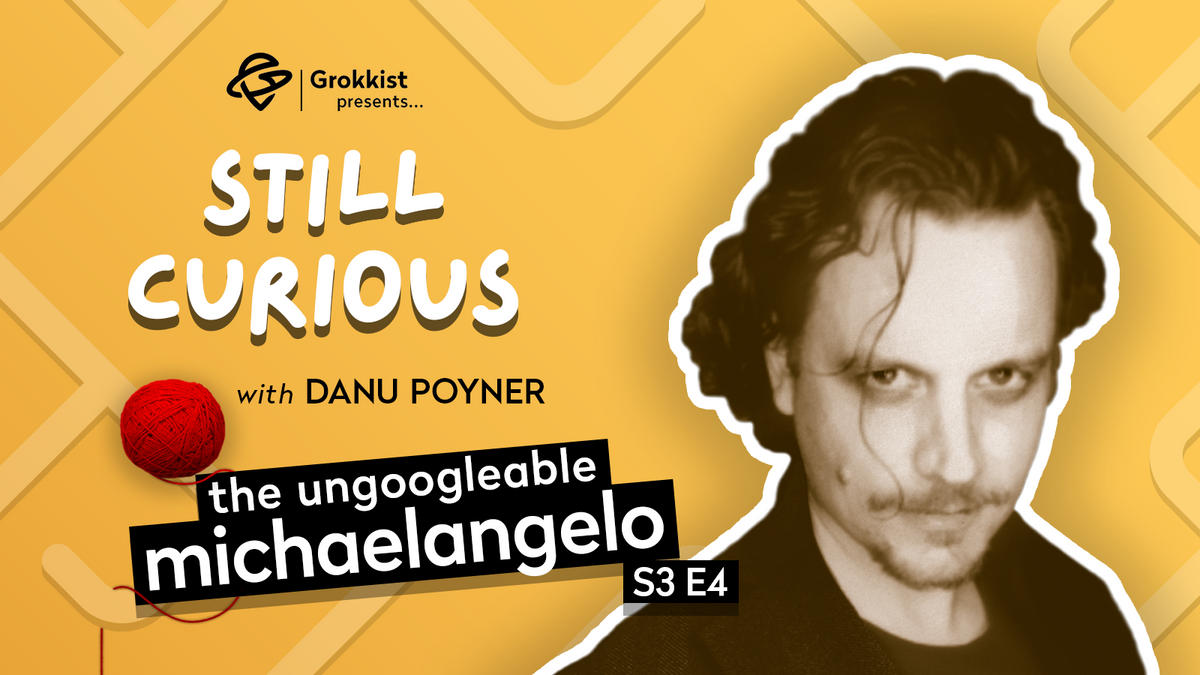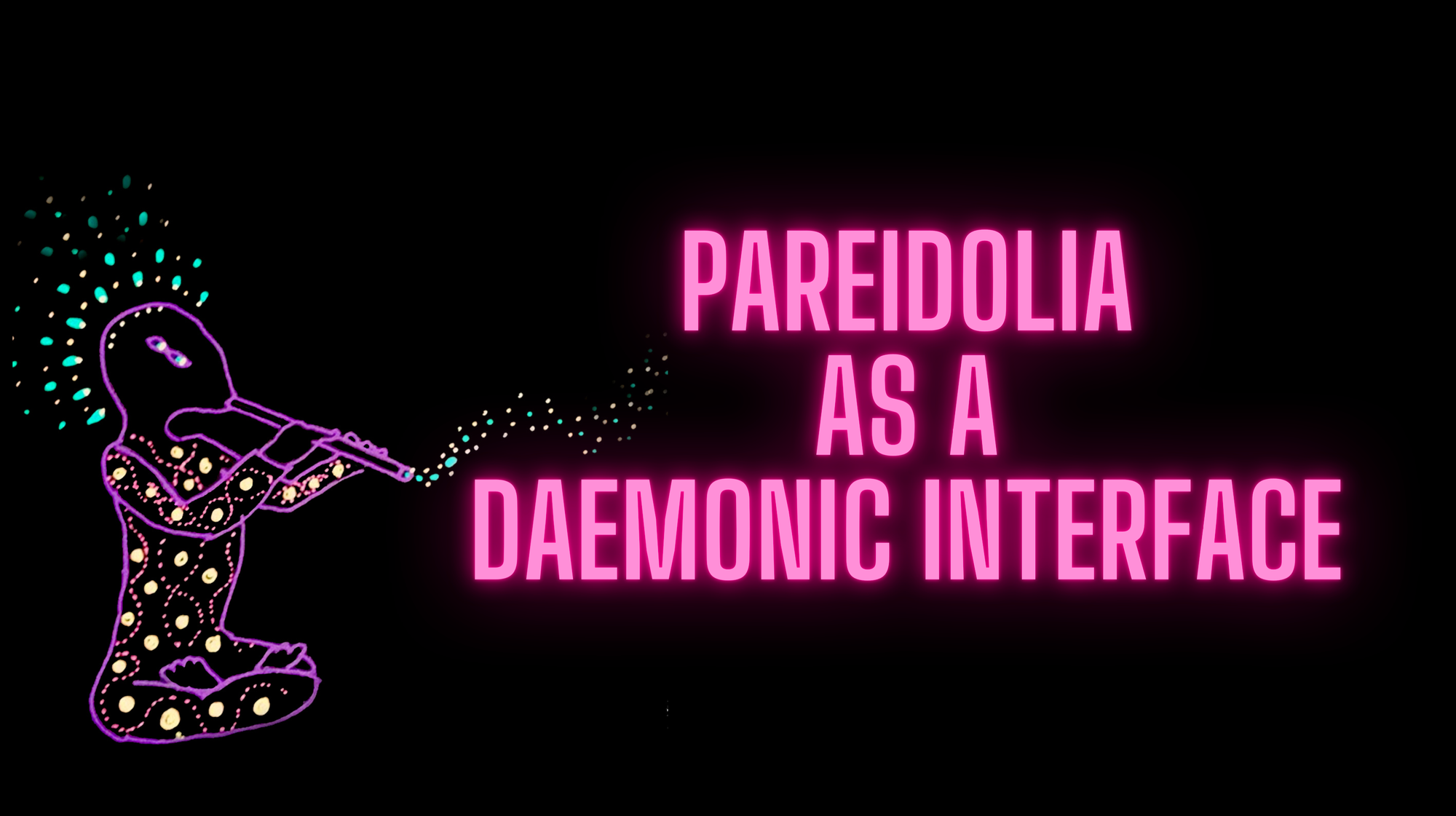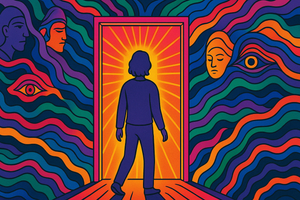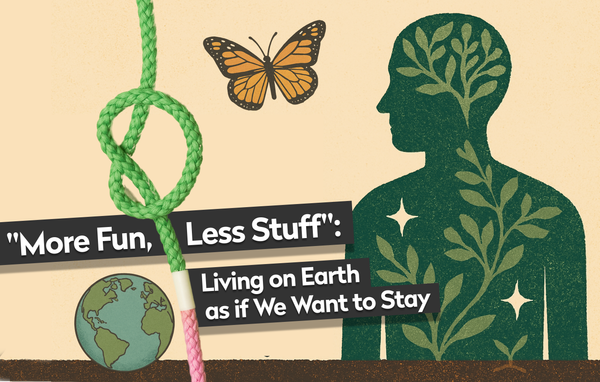Watch my Grok Talk presentation (35 min)
A bit about me
I’m Michaelangelo, the Ungoogleable Michaelangelo. How do I describe what I do or who I am? I like the umbrella term “artist,” but if you want to add a little flair, let’s go with “multidimensional artist.” My work spans various media, but today, I want to share with you a unique approach I’ve developed called “pareidolic divination” – divinatory art.
Pareidolia might sound like a strange, alien word, but it’s actually something we all experience. It’s the mind’s tendency to find meaningful patterns in random stimuli—like seeing faces in clouds or Jesus on toast.
In this talk, I’ll show you how I use pareidolia as a kind of daemonic interface. Now, when I say “daemonic,” I’m not talking about something evil or sinister.
Think of it more like the Greeks’ concept of a genius—a guiding spirit, a kind of angel on your shoulder whispering insights from beyond the boundaries of how we usually see ourselves.
What is a Daemonic Interface?
Now, let’s dive deeper into the concept of pareidolia as a daemonic interface. This is where things get interesting.
I like to think of the daemon as a sort of inner guide, similar to the ancient Greek idea of a genius—an externalized part of ourselves that whispers insights from beyond our usual understanding.
There’s always more to us than we consciously know—an ocean of darkness that surrounds the candlelit flame of our selfhood. Through pareidolia, I try to open portals into this larger part of the self.
Some people call it the “higher self,” but why give it a dimension of height? It could just as easily be the “wider self,” the “deeper self,” or the “inverted self,” however you want to look at it.
This process allows me to tap into those hidden aspects, trusting that what I don’t know yet will reveal itself as I go along. It’s about letting the subconscious unfold and reveal itself through the act of creation.
The Art of Divinatory Creation
Let me take you through my process with a bit of a show-and-tell to share with you some of my work and how it came to be.
One of the first pieces I want to share with you is a painting I did back in 2014 called “Bakuim.”

The name comes from a fictitious Hebrew plural of “Baku,” a mythical creature from Japanese folklore known as the dream eater. Legend has it that if you wake up and can’t remember your dreams, it’s because the Baku ate them.
This painting emerged from a series of dreams I had about a Baku bazaar, where dream merchants were selling people’s dreams back to them. The central figure in the painting came to symbolize a deeply personal experience for me, connected to my time working with ayahuasca in Peru.
For my ex-girlfriend, who later got a tattoo of this painting, the weeping figure represented herself, while the other figure, the Baku, represented me supporting her. The serpent shared between them could be seen as the connection between us, possibly representing the ayahuasca vine, often symbolized as a snake in shamanic traditions.
This piece was created using the very techniques I’m sharing with you today. It’s a more sophisticated example of what can come out of pareidolic divination, and it shows how the subconscious can guide us to create something deeply meaningful without us fully understanding it at the outset.
Stain Spotting: Turning Obstacles into Oracles
As my work evolved, I realized that not everyone connects with complex, intricate paintings like “Bakuim.” Some people would look at my work and feel overwhelmed, thinking they could never create something similar.
I wanted my art to be more accessible, to invite people in rather than push them away. So, I simplified my approach.
I moved away from the intricate, time-consuming studio paintings and started focusing on more immediate forms of expression. This shift led to what I now call “divined designs” and “Pareidoodles”—smaller, more accessible pieces that still carry the same depth of meaning but are easier for people to connect with.

Let’s talk about one of my more unconventional methods—something I call “stain spotting.” This practice started as a simple, playful exercise. Armed with a piece of chalk, I would walk around the streets, spotting shapes in random stains on the sidewalk, and outline them. What began as a whimsical activity quickly turned into something much deeper—a form of “cave art on concrete.”
Stain spotting is about transforming what we typically see as obstacles into oracles. Concrete, which we often think of as the most inert, lifeless material, becomes a “psychic teleprompter” that offers glimpses into the deeper self.
These stains, once outlined, reveal characters and stories that seem to come from a place beyond conscious awareness. It’s as if the material world becomes a springboard, connecting us with that daemonic dimension.

I started seeing all kinds of things—little mother and child figures, strange animal-human hybrids, and even surreal, dream-like scenes.
These images were always there, hidden in the randomness of everyday life, just waiting to be uncovered. And once they are, they speak to something within us—something primal, something we might not even know exists.
Embracing the Unconscious
One of the most powerful aspects of this approach is how it encourages us to embrace the parts of ourselves that we might otherwise ignore or repress.
The characters that emerge from my art are often strange, eccentric, and sometimes unsettling. Yet these are aspects of the self that deserve to be seen, heard, and accepted. By engaging in this form of art, we create a space where even the most estranged parts of ourselves can be acknowledged and integrated.
The daemonic, in this sense, is not something to be feared but something to be welcomed. It’s the larger expression of ourselves, often the parts we’re not entirely comfortable with.
Through divinatory art, we can bring these parts to the forefront, greet them, and embrace them back into totality.

From New York to Mexico: A Journey of Transformation
My journey as an artist has taken me to many places, each leaving its mark on my work. During my time in New York, for instance, I became fascinated with the grime and filth of the city streets. Where others saw dirt and decay, I saw potential—rich, untapped potential. The grime of the city became my canvas, and I started creating what I now call “grime galleries,” finding life in the most unexpected places.

Later, during my time in Mexico, my work took on a new dimension. I found myself collaborating with other artists, blending their styles with my own. This period was transformative for me, not just in terms of technique but in terms of how I viewed my role as an artist.
I began to see art as a collaborative process, a merging of minds and modalities that allowed for new and unexpected forms of expression.
The Power of Pareidolia and the Vestige of Vigilance
At its root, pareidolia uncovers an ontologically profound truth: the faces we see in clouds, the characters that emerge from stains, are not just projections onto the external world—they reveal something about how we process reality.
The sensorial input of the outside world is processed inside us before it’s projected and simultaneously perceived as external. And in that process, we imbue the senseless, tasteless, colorless world with the quaintness of qualia—those subjective, conscious experiences that make life rich and meaningful.

This phenomenon isn’t just a curious little quirk of the mind; it’s likely an evolutionary vestige of vigilance.
Imagine our ancestors, wandering the grasslands, keeping their eyes peeled for the faces of predators or enemies hidden in the brush. There’s always been this kind of facial recognition pattern mapped onto our perception of the external world. It was a survival mechanism—if you could spot the face of a lurking predator quickly, you were more likely to survive.
But what happens when there’s no immediate threat? When it’s just you, safe, within the confines of your home?
That’s when this vigilance relaxes, when that clenched fist of awareness opens up like a flower, allowing faces to appear in places where there are none. This ability to see faces in random patterns becomes less about survival and more about a playful engagement with the world around us, a way of making the mundane magical.
Some recent articles suggest that this ability might explain why ancient humans created cave art in the first place.


The theory goes that the cave artists of old, working by firelight in their caverns, were inspired by the textures and patterns on the rock walls. Just like how I spot characters in the stains on the sidewalk today, they might have seen forms in the flickering shadows and outlines in the stone, and then brought them to life through their art.
Divined Designs: Capturing the Sublime in the Simple
In my own work, this pareidolic perception manifests in what I call “divined designs.” These are pieces that are less about planned creation and more about capturing something spontaneous, something that emerges naturally from the process. They’re co-creations, in a sense, between me and whatever forces or energies are at play in that moment.

The key is not to overthink it, not to get bogged down in details, but to capture that initial spark of inspiration before the conscious mind starts to dissect it.
“Divined designs” are my way of making the profound more accessible, of distilling the vast and the sublime into something simple yet resonant. These works aren’t about perfection; they’re about the moment of creation itself, that instant when the daemonic interface—the connection between conscious and unconscious—comes alive.


And then there are “pareidoodles,” which are even more condensed versions of these divined designs. They’re quick, spontaneous creations, often done in minutes, but they carry the same depth of meaning as larger pieces. These doodles are like little windows into the unconscious, captured in just a few lines or shapes.
The beauty of pareidoodles is their simplicity—each one is a direct, unfiltered expression of the creative impulse, a glimpse into the hidden aspects of the self.


What’s interesting is that sometimes these pieces—these quick, spontaneous creations—are what I call “unconscious printouts.” They’re things that we might consider to be of less value than the real work, the pieces we labor over and refine.
But often, because these printouts come out without the filters of control or self-editing, they end up being purer expressions, more relatable to others because they’re raw and uncurated. I’ve talked about this on Danu's Still Curious podcast as well—how these unconscious printouts can sometimes hold more truth, more of ourselves, than the work we try so hard to perfect.

The Daemonic Within Us All
Ultimately, this exploration of pareidolia as a daemonic interface is about more than just creating art—it’s a way to connect with the unconscious and bring forth the hidden, the strange, and the wondrous.
It’s about recognizing that the faces we see in clouds, the characters we find in stains, and the figures that emerge from the unconscious are all part of a larger, ongoing dialogue with the self.
This process invites us to step into a world where the random becomes meaningful, where the unknown becomes a source of creative power. It’s an invitation to explore the depths of our own minds, to embrace the strange and the unfamiliar, and to find beauty in the unexpected.
So, as you go about your day, I encourage you to look at the world a little differently. What shapes do you see in the clouds? What stories do the stains on the sidewalk tell?
And most importantly, what do these images reveal about you? The answers might surprise you, and they might just open up new portals into the vast, unexplored territories of your own mind.










Member discussion